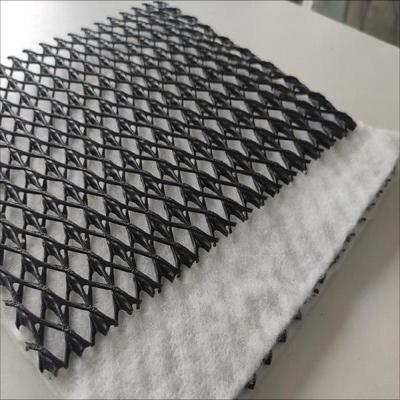1. Causes of loss
1. Improper construction operation: During the laying process of the three-dimensional composite drainage net, if the operator does not strictly follow the construction specifications, such as excessive stretching, folding, twisting, etc., the material may be damaged and loss may occur. Using sharp tools to scratch the surface of the material will also affect its integrity and drainage performance.
2. Environmental factors: Environmental conditions at the construction site, such as temperature, humidity, wind, etc., may affect the three-dimensional composite drainage net. In a high temperature environment, the material may deform due to thermal expansion; in a humid environment, the material may soften due to water absorption, reducing its mechanical strength.
3. Material quality problems: If the three-dimensional composite drainage net itself has quality problems, such as uneven material, inconsistent thickness, insufficient tensile strength, etc., it may be easily damaged during construction, resulting in loss.
2. Factors affecting loss
1. Construction difficulty: The topography, geological conditions, etc. of the project will affect the construction difficulty of the three-dimensional composite drainage net. Construction under complex terrain or poor geological conditions often requires more operating steps and higher technical requirements, which will increase the risk of material loss.
2. Material specifications and performance: Three-dimensional composite drainage nets with different specifications and performances have different anti-loss capabilities. Generally speaking, materials with thicker thickness and higher tensile strength are less likely to be damaged during construction.
3. Construction management level: The level of construction management directly affects the loss of three-dimensional composite drainage nets. Good construction management can ensure the standardization and orderliness of the construction process and reduce material loss caused by human factors.
III. Loss control measures
1. Strengthen construction training: Provide professional training for construction personnel to improve their operating skills and safety awareness to ensure the standardization and accuracy of the construction process.
2. Optimize construction plans: According to the actual situation of the project, formulate scientific and reasonable construction plans, clarify construction steps and technical requirements, and reduce unnecessary operations and material waste.
3. Select high-quality materials: Select three-dimensional composite drainage nets with reliable quality and stable performance to ensure that the materials can withstand the influence of various external forces and environmental factors during the construction process.
4. Strengthen on-site supervision: During the construction process, strengthen on-site supervision, promptly discover and correct irregular behaviors in construction, and ensure construction quality and material safety.
5. Reasonable planning of material use: According to the project requirements and material properties, the amount of material used and the laying method should be reasonably planned to avoid material waste and loss.
From the above, it can be seen that the three-dimensional composite drainage network may indeed cause loss during the construction process, but by strengthening construction training, optimizing construction plans, selecting high-quality materials, strengthening on-site supervision, and reasonably planning the use of materials, the loss can be controlled and the economic and social benefits of the project can be improved.
Post time: Jun-26-2025




